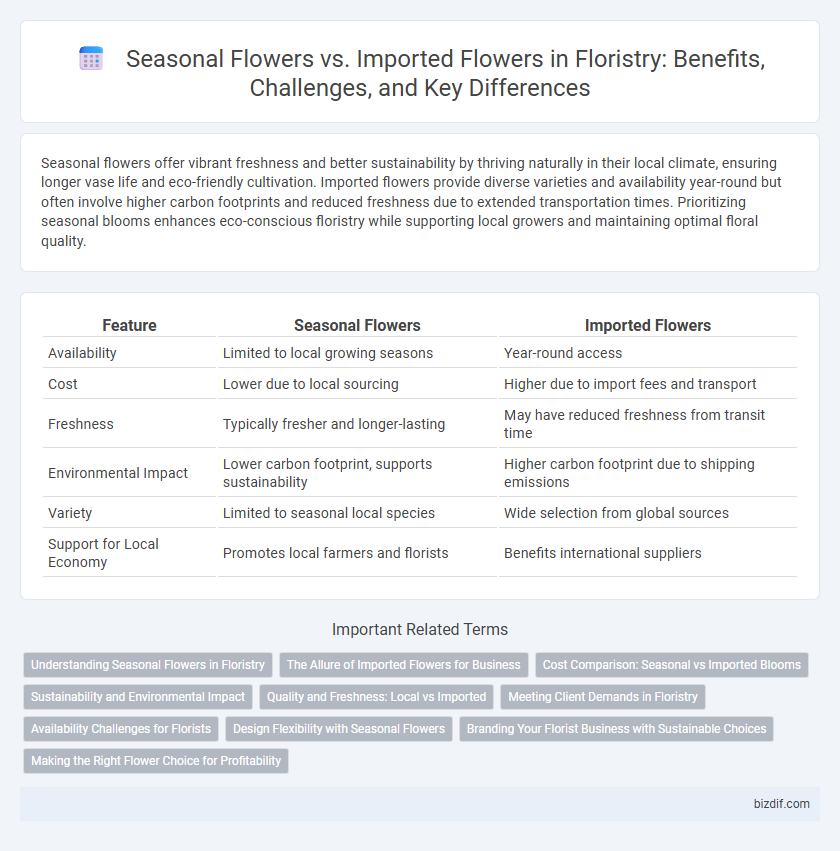Seasonal flowers offer vibrant freshness and better sustainability by thriving naturally in their local climate, ensuring longer vase life and eco-friendly cultivation. Imported flowers provide diverse varieties and availability year-round but often involve higher carbon footprints and reduced freshness due to extended transportation times. Prioritizing seasonal blooms enhances eco-conscious floristry while supporting local growers and maintaining optimal floral quality.
Table of Comparison
| Feature | Seasonal Flowers | Imported Flowers |
|---|---|---|
| Availability | Limited to local growing seasons | Year-round access |
| Cost | Lower due to local sourcing | Higher due to import fees and transport |
| Freshness | Typically fresher and longer-lasting | May have reduced freshness from transit time |
| Environmental Impact | Lower carbon footprint, supports sustainability | Higher carbon footprint due to shipping emissions |
| Variety | Limited to seasonal local species | Wide selection from global sources |
| Support for Local Economy | Promotes local farmers and florists | Benefits international suppliers |
Understanding Seasonal Flowers in Floristry
Seasonal flowers thrive naturally during specific times of the year, offering fresher blooms and richer colors compared to imported flowers, which may endure long transit times and chemical treatments. Utilizing seasonal flowers in floristry maximizes sustainability and supports local growers, reducing carbon footprints associated with transportation. Florists benefit from enhanced availability and cost-effectiveness when selecting blossoms that align with regional growing cycles and customer preferences.
The Allure of Imported Flowers for Business
Imported flowers captivate business owners with their exotic varieties and extended availability beyond local growing seasons, ensuring a diverse and premium floral selection year-round. Their consistent quality and unique appeal attract clientele seeking exclusive blooms, enhancing brand prestige and customer satisfaction. Leveraging imported flowers enables florists to meet high-demand events and upscale markets, driving increased sales and competitive advantage.
Cost Comparison: Seasonal vs Imported Blooms
Seasonal flowers typically cost 30-50% less than imported blooms due to reduced transportation and storage expenses. Imported flowers incur higher prices from international shipping, customs fees, and longer supply chains that require refrigerated handling. Florists often prefer seasonal flowers for budget-friendly arrangements without compromising freshness or quality.
Sustainability and Environmental Impact
Seasonal flowers grown locally significantly reduce carbon emissions due to minimal transportation and lower energy use compared to imported flowers, which often require extensive air freight and refrigeration. Locally sourced seasonal blooms promote sustainable farming practices by supporting biodiversity and reducing the need for chemical interventions often used in large-scale imports. Choosing seasonal flowers enhances environmental stewardship by minimizing water consumption and waste associated with long supply chains.
Quality and Freshness: Local vs Imported
Seasonal flowers thrive in their natural growing period, ensuring peak freshness and vibrant colors due to minimal transit time from farm to florist. Imported flowers often endure longer shipping durations and exposure to preservation chemicals, which can compromise their quality and reduce their lifespan. Choosing local seasonal blooms supports quicker delivery and less environmental impact, guaranteeing superior freshness for floral arrangements.
Meeting Client Demands in Floristry
Seasonal flowers fulfill client demands by offering fresh, vibrant blooms that reflect current local growing conditions, enhancing sustainability and cost-effectiveness. Imported flowers expand the floristry palette year-round, providing rare varieties and colors unavailable locally, meeting diverse aesthetic preferences and high-end client requests. Balancing seasonal availability with strategic imports ensures florists can consistently deliver customized arrangements that satisfy evolving market trends.
Availability Challenges for Florists
Seasonal flowers offer florists greater availability and fresher quality due to their natural growth cycles and local harvesting, reducing supply chain delays and costs. Imported flowers often face challenges such as transportation time, customs clearance, and temperature sensitivity, leading to potential damage and limited stock variations. These availability issues make seasonal flowers a more reliable choice for maintaining consistent inventory and meeting customer demand.
Design Flexibility with Seasonal Flowers
Seasonal flowers offer greater design flexibility due to their availability, freshness, and variety throughout the year, allowing florists to create unique, vibrant arrangements tailored to each season's palette. Imported flowers, while exotic, often face limitations in freshness and availability, restricting spontaneous design adjustments and increasing costs. Utilizing seasonal blooms enhances creativity and sustainability in floral design by aligning with natural growth cycles.
Branding Your Florist Business with Sustainable Choices
Choosing seasonal flowers enhances your florist business's brand by promoting sustainability through reduced carbon footprint and supporting local growers. Emphasizing eco-friendly practices and showcasing locally sourced blossoms appeals to environmentally conscious customers, boosting brand loyalty and market differentiation. Integrating seasonal floral selections into your marketing strategy elevates your florist's reputation for commitment to sustainability and quality.
Making the Right Flower Choice for Profitability
Seasonal flowers often provide higher profitability due to lower costs and increased freshness, attracting customers seeking vibrant blooms. Imported flowers can offer exotic variety and availability year-round but typically incur higher expenses, reducing profit margins. Balancing local seasonal blooms with select imported varieties optimizes inventory, satisfies diverse customer preferences, and maximizes overall floral business revenue.
Seasonal flowers vs Imported flowers Infographic

 bizdif.com
bizdif.com